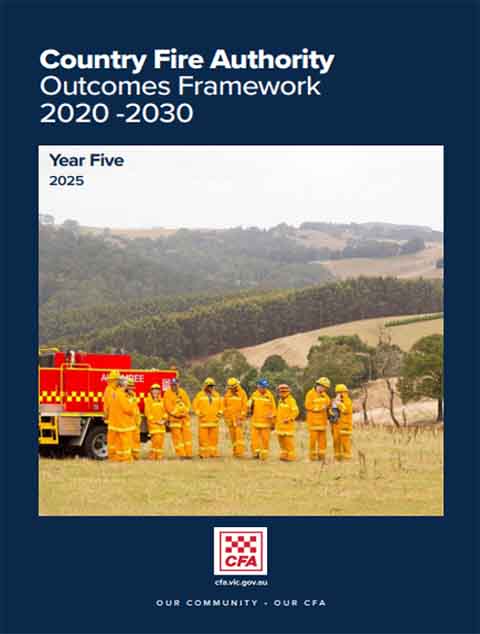CFA is the community’s fire authority. We are more than 50,000 members committed to protecting lives and property. Our members are key to the success of CFA with their deep connection to their local area and unique understanding of their community risk. We acknowledge the special role generations of Traditional Owners have played in stewardship of the land and their ongoing role in caring for country – an endeavour in which CFA has a shared interest.
Our community and environment are continually changing and demand for our services is growing. Our climate continues to present challenges as fire seasons become longer and more intense. We must continue to focus on partnering with the diverse range of communities across Victoria, considering their needs and empowering them to plan and prepare for fire and other emergencies.
This strategy and the accompanying Outcomes Framework set a clear pathway for our organisation, positioning us to meet the changing needs of our members and the community. The mid-term review of the strategy has been an opportunity to work with CFA volunteers, staff, stakeholders and community members to reflect on the evolving opportunities and challenges facing CFA and the community, now and in the future. I am grateful for the thoughtful contributions from volunteers, staff, stakeholders and community members.

This strategy builds on our strengths and capabilities in the areas where communities need us most. It recognises the breadth of our work that goes far beyond fire response and the unique value that CFA, as a community-based volunteer service, brings to Victorians.
The reform of Victoria’s fire services in 2020 led to profound changes for CFA. We continue to work with Fire Rescue Victoria, the Department of Justice and Community Safety and the broader emergency management sector to seek to ensure government’s policy intent of this reform is fulfilled. This includes a complementary operating model that draws on the existing strengths of both fire agencies with the aim that all Victorians receive a world-class fire service response no matter where they live.
The strategy outlines our commitment to community members, to put them at the centre of all our decisions and to deliver high-quality services that make a positive difference. Just as importantly, it reinforces our commitment to our people to provide a safe and healthy working environment and to be a future focused and innovative emergency services organisation.
I am pleased to present this strategy which details our ongoing commitment to achieving our vision that Victorian communities are prepared for and safe from fire.
Jo Plummer
Board Chair
We acknowledge Aboriginal and Torres Strait Islander people as the Traditional Custodians of the land.
We pay our respects to Elders, past and present.
We are committed to inclusive communities
CFA is a child safe organisation
In late 2024 we undertook a mid-term review of the CFA Strategy and Outcomes Framework 2020-2030 to determine whether it needed updating as a result of internal or external changes since its development in 2020. This was particularly relevant given the significant events during this time including the implementation of Fire Services Reform and the COVID-19 pandemic.
The review showed that despite these influencing factors CFA’s high-level focus remains appropriate. It highlighted that the strategy could be clearer about the strategic focus we place on ensuring a strong and sustainable volunteer workforce and CFA’s significant role as a support agency at incidents other than fire.
Who helped us review the strategy
We engaged with our members, key stakeholders and the community to ensure all relevant stakeholders had an opportunity to have a say and help shape the future of CFA.
Members and key stakeholders
Members and key stakeholders were asked for feedback and input into the development of the refreshed strategy and were kept informed throughout the process.
Our community
The community was asked for feedback on the draft refreshed strategy and opportunities to work together to achieve our goals.
Members and key stakeholders
Members and key stakeholders were asked for feedback and input into the development of the refreshed strategy and were kept informed throughout the process.
Our community
The community was asked for feedback on the draft refreshed strategy and opportunities to work together to achieve our goals.
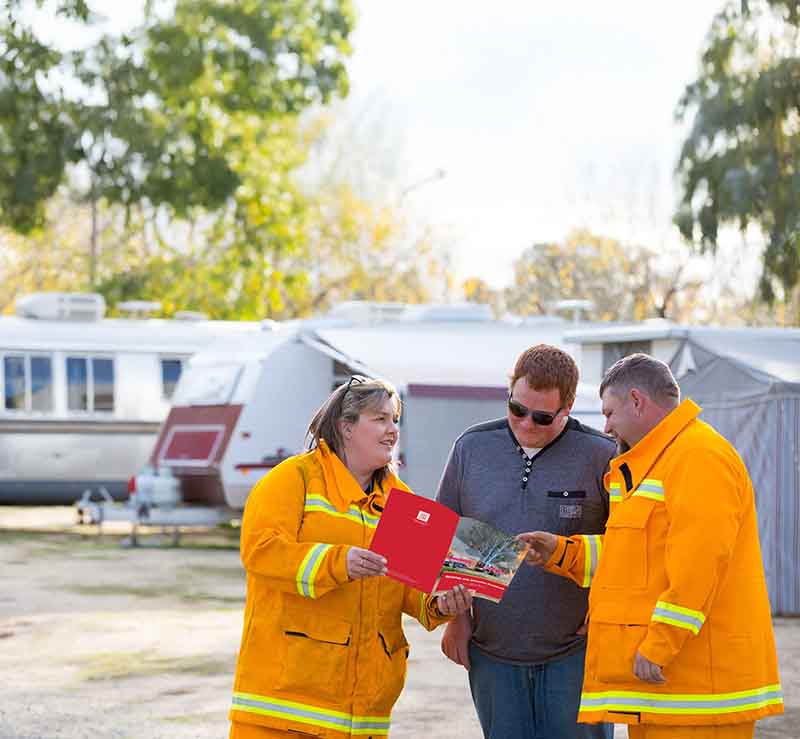
Our strategy sets a strong, ambitious direction for our organisation. It describes what CFA is striving to achieve, the work we will do to get there and how we will know we are making a difference.
The components of our strategy are explained below.
Strategy on a page
MISSION
To protect lives and property
VISION
Victorian communities are prepared for and safe from fire
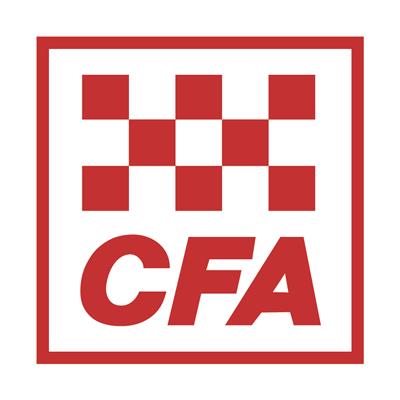
1.1
The community has confidence in our people, advice and services
1.2
The community is educated, engaged and empowered to manage its fire risk
2.2
Fires are suppressed quickly and effectively
2.3
Fires are less harmful to the community
2.4
Our response to on-fire related incidents effectively reduces the adverse impacts on the community
3.1
Our workplace is safe
3.2
We have a volunteer and paid workforce that reflects the communities it serves
3.3
We uphold the CFA values and are held accountable for our behaviour
3.4
Our volunteers and staff are empowered and supported to successfully fulfill their role
3.5
We have a sustainable volunteer workforce
4.1
We are financially sustainable, and our resource allocation decisions are transparent and achieve the greatest possible impacts
4.2
Our corporate governance arrangements are based on evidence and evaluation to maximise the benefits for our people and the community
4.3
We collaborate with Fire Rescue Victoria and other service delivery partners to promote interoperability and build stronger relationships that lead to better community outcomes
4.4
We work with Emergency Management Victoria and other government departments and agencies to support government objectives and emergency management reform
Our Values: We put SAFETY first We excel through TEAMWORK We are dynamic and ADAPTABLE We act with INTEGRITY We RESPECT each other
We are thousands of Victorians committed to protecting lives and property.
80+ years
Serving the community, with a proud history for many brigades that pre-dates the Authority's formation in 1945
50,000+
Operational, support
and junior volunteers
1,200+
Brigades across
21 districts
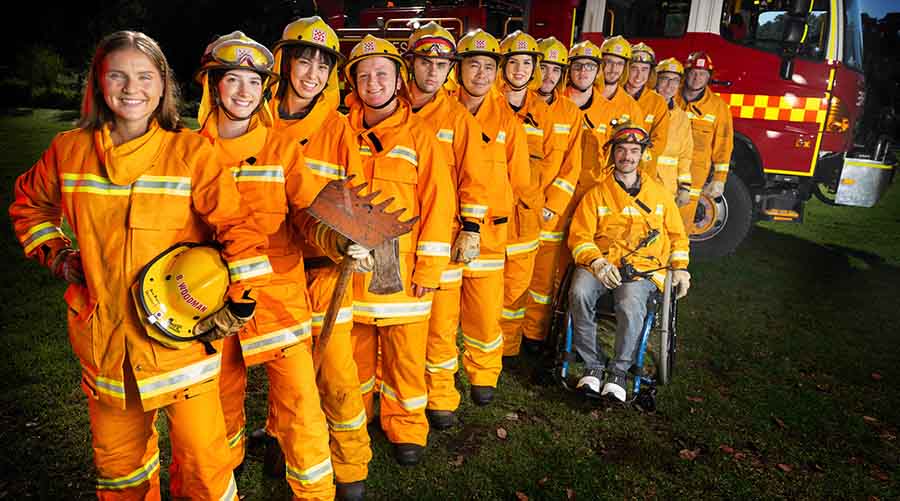
We support our communities through a wide range of activities for mitigation, response, relief and recovery from emergencies.
CFA volunteers respond to structure fires and wildfires and provide and support motor vehicle accident first response across the state. They also attend incidents at complex industrial sites such as mines, gas plants and energy generation facilities including power stations, solar and wind farms, and large battery storage facilities.
We have a strong focus on engagement to build community preparedness for fire and other emergencies by enhancing knowledge, developing skills, strengthening connection to CFA, and developing understanding of our shared responsibilities for fire safety. We play a major role in the state’s incident management arrangements, and we also support other agencies and government departments in preparing for and responding to all major incidents.
The CFA Service Catalogue provides a consolidated view of our core and enabling services.
OUR CORE SERVICES
Community Preparedness
Fire prevention and preparedness
Emergency response fire suppression
Incident/emergency management planning, preparedness and response
Emergency response non-fire
Regulatory services
Our enabling services help us to effectively and efficiently deliver our core services
- Governance, legal and risk
- Resource management
- Develop and manage human capital
- Training
- Communication and engagement
- Asset management
- Information and knowledge management
- Continuous improvement
- Volunteerism and membership
- Health, safety and wellbeing
The community is at the centre of all that we do and collaborating and working together is key to safer and more resilient communities.
CFA works closely with Volunteer Fire Brigades Victoria (VFBV) and our volunteer members directly to consult and work collaboratively on matters that affect them, as set out in the Volunteer Charter.
Our partnerships with other agencies and departments within the emergency management sector are also critical to the successful delivery of services to the community.
Complementary fire services are delivered through CFA, Fire Rescue Victoria and Forest Fire Management Victoria seeking to ensure that all Victorians receive a world-class fire service response no matter where they live.
Our operating environment is continually changing and we need to ensure that we can adapt quickly and continue to serve and protect our community.
Fire Services Reform
The significant change to Victorian fire services came into effect on 1 July 2020, confirming CFA as a community-based, volunteer firefighter organisation and creating Fire Rescue Victoria which brought together career firefighters from CFA and the former Metropolitan Fire Brigade.
The implementation of Fire Services Reform is challenging and complex and we remain committed to working with our partners to ensure the best outcomes for the community we all serve. This includes an ongoing focus on creating true interoperability of services and working with Fire Rescue Victoria and the government to address the challenges being experienced in the implementation of the Secondment Agreement, which is a foundational element of the reform.
Our community is expanding and becoming more diverse
Victoria’s population has grown steadily in the past 20 years and is predicted to increase from the 6.5 million people recorded in the 2021 census to 11.2 million people by 2056. As the population grows, so does the number of Victorians who rely on CFA for emergency services.
The population is also becoming more diverse. Overseas migration is a major component of Victoria’s population growth, with more than 30 per cent of our population born overseas. The population is also ageing, impacting the availability and capacity of volunteers and requiring CFA to provide services to an increasing number of vulnerable people.
As Victoria grows and changes, it is increasingly important that CFA programs and services adapt and evolve and that our volunteer and paid workforce reflects the communities we serve.
Where and how we live is evolving
Victoria is Australia’s smallest mainland state in geographic size but the most densely
populated and urbanised. The modern homes we live in, the higher density of many of
our neighbourhoods, and where people choose to live means that the fire risk facing our
communities is changing.
The settlement of Victoria has led to a large area of potential peri-urban development
surrounding Melbourne and the major regional cities of Geelong, Ballarat, Bendigo, Wodonga and
Latrobe. Many people live on the urban fringe, where grassfire and forest fire risk can be high.
The COVID-19 pandemic also impacted where and how we live in recent years. Before the
pandemic, Victoria’s regional population was declining. However the normalisation of more
flexible working arrangements and people’s changing priorities have led to the population of
regional Victoria growing at a slightly faster pace than the overall state.
Modern homes also present unique challenges for fire suppression. While we now have more
options for early detection and residential fire suppression systems, such as smoke alarms and
residential sprinklers, many modern homes can provide less fire protection than historic homes.
Larger homes, open plan layouts and increased fuel loads, including more synthetic home
furnishings and new construction materials, mean house fires spread more quickly, providing
less time for residents to evacuate and decreasing the time from fire ignition to total structure
collapse. Time to flashover is a critical threshold for injuries, loss of life and property damage.
Research has demonstrated that typical home layouts with modern furnishings can progress
to flashover in as little as two to three minutes, whereas similar tests conducted in the 1970s
resulted in typical flashover times of 10 to 20 minutes.
As our communities change, we must adapt our approach to target the changing risk
environment.
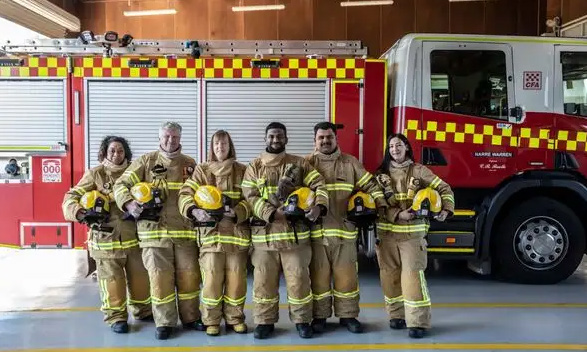
Natural disasters are becoming more expensive
Natural disasters including bushfires, can be costly for communities,
causing loss of property, stock and livelihoods, damage to agricultural and
community infrastructure, and in some cases significant injury and death.
In economic terms, the cost of natural disasters in Australia is increasing.
Scaling up investment in both physical resilience (such as infrastructure)
and community resilience (such as preparedness programs) will help
reduce the significant anticipated costs from natural disasters.
Expectations are shifting
Like all government agencies, CFA needs to ensure it can perform its role
efficiently and effectively with available resources.
Technological advancements including smart devices, mobile
communication and social media are changing the way communities
receive information and how and when they expect to be engaged. We
need to look at how we can use innovation to reach our community in
ways that work for them.
Shifting expectations are not limited to government and the community;
the expectations of our volunteers are also shifting. The rate of formal
volunteering through an organisation in Australia has declined over time.
For people aged 18 years and over, the rate decreased from 36.2 per cent
in 2010 to 28.8 per cent in 2019.
The number of hours people can devote to volunteering is also
decreasing. Volunteers contributed 596 million hours to the community
in 2019, a 20 per cent decrease in the total number of volunteering hours
from 2014. Australians lead busy lives and work hard to manage the various
personal and professional priorities competing for their time. COVID-19
also impacted people’s priorities and ability to volunteer. Volunteers
expect flexibility and agility and CFA must rise to this challenge to ensure a
sustainable workforce and a high-quality volunteer experience.
Our goals and outcomes
Our goals detail what we are striving to
achieve over the life of the strategy to
support the delivery of our mission and vision.
The outcomes are the changes we want to see
as a result of the work we are doing with our
sector partners and the community.
Goal 1
We put the community at the centre of
everything we do
To properly serve the community, they must be at the centre of our planning, decision-making and service delivery. Building strong, trusting relationships can help the community manage fire risk and stay safe.
The reach of our network of brigades throughout Victoria is our strength. CFA is recognised and present from outer suburbs to remote townships.
Our members are key to the success of CFA because they are deeply connected to their local area and have a unique understanding of their local community risk.
What will success look like?
We will be successful if we achieve the following outcomes:
✓ The community has confidence in our people, advice and services
✓ The community is educated, engaged and empowered to manage its fire risk
To achieve success, we will focus on:
✓ Understanding the communities we serve and tailoring our services and advice to meet their unique needs
✓ Supporting community resilience so that people can withstand emergency events, prepare and respond appropriately, and recover quickly
✓ Building trust and respect to ensure that community members listen to CFA warnings and advice, access our services and partner with us to understand, identify and manage fire risks
✓ Engaging with our communities in ways that work for them and meet their unique needs and preferences
✓ Working to expand our reach in the community and improve the practical impact of our engagement
✓ Advocating for complementary fire services arrangements that ensure Victorians receive the best fire and emergency response regardless of where they live
Goal 2
We provide programs and services that make a
positive difference
CFA volunteers and staff deliver prevention, preparedness, response and recovery programs and services to more than two million Victorians. Whether delivering community education programs to prevent fires, responding effectively to fires that have occurred, providing other specialist services (such as HazMat, rescue, tech rescue, mines and medical response programs) or supporting other agencies, the services we deliver seek to achieve our vision. We have an obligation to our communities, and to our own people, to invest in meaningful service delivery that maximises benefits and manages and seeks to minimise risks.
What will success look like?
We will be successful if we achieve the following outcomes:
✓ Fires are prevented
✓ Fires are suppressed quickly and effectively
✓ Fires are less harmful to the community
✓ Our response to non-fire-related incidents effectively reduces the adverse impacts on the community
To achieve success, we will focus on:
✓ Continuous improvement of prevention activities and response to fire and non-fire related incidents to minimise impacts on the community
✓ Measuring our performance based on the outcomes we achieve and continuously improving the programs and services we deliver
✓ Tailoring our programs and services to the local risk environment and the needs of each community
✓ Strengthening our relationships with partner agencies, so that we can work together and play our part to achieve the sector-wide vision of safer and more resilient communities
Goal 3
We provide a great place to volunteer and work
CFA relies on our volunteers to deliver its programs and services to Victorians and thousands of visitors to the state each year. Our dedicated volunteers are supported by hundreds of staff who work at the local and state level to build capability and support service delivery. Our people, whether volunteer or staff, are committed to the protection of life and property.
To have a sustainable workforce, we need to be an organisation of choice, making CFA a great place to volunteer and work. We need to provide every volunteer and staff member with a safe, inclusive and supportive environment to ensure they continue to be part of CFA into the future.
We acknowledge and respect the significant sacrifices that our volunteers and their families make in their own lives to contribute to CFA and their communities, and CFA needs to ensure that we enable them to achieve the best possible outcomes from the time they devote to CFA work.
What will success look like?
We will be successful if we achieve the following outcomes:
✓ Our workplace is safe
✓ We have a volunteer and paid workforce that reflects the communities it serves
✓ We uphold the CFA values and are held accountable for our behaviour
✓ Our volunteer and paid workforce is appropriately skilled, resourced, empowered and is continually learning
✓ We have a sustainable volunteer workforce
To achieve success, we will focus on:
✓ Providing a physically and mentally safe environment for our people where they feel welcome, included and supported to undertake their duties
✓ Focusing on inclusion and fairness and creating a workplace culture that values gender, cultural and generational diversity at all levels of the organisation
✓ Ensuring CFA’s volunteer membership model and member services are contemporary and meet the needs of our people
✓ Providing ways for members to share their experiences to underpin continuous improvement and responding to all complaints in a timely and appropriate manner
✓ Providing fit for purpose training for our people so that operational and support personnel have the skills they need to fulfil their roles successfully and safely
✓ Focusing on the attraction, induction and retention of volunteers to ensure a sustainable volunteer workforce
Goal 4
We are a future focused emergency service
CFA has been supporting the Victorian community for 80 years, as one of the first volunteer firefighting services in Australia and many volunteer brigades were formed well before CFA’s creation. Much has changed since our establishment, including the communities we serve, their expectations, the built and natural environment and the regulatory and legislative context in which we operate.
As a future focused emergency service, we embrace change and innovation to ensure we remain a sustainable, people focused organisation. This means regularly assessing and adapting to our changing environment and making the best evidence-based decisions to maximise the benefit for the community.
What will success look like?
We will be successful if we achieve the following outcomes:
✓ We are financially sustainable, and our resource allocation decisions are transparent and achieve the greatest possible impacts
✓ Our corporate governance arrangements are based on evidence and evaluation to maximise the benefits for our people and the community
✓ We collaborate with Fire Rescue Victoria and other service delivery partners to promote interoperability and build stronger relationships that lead to better community outcomes
✓ We work with Emergency Management Victoria and other government departments and agencies to support government objectives and emergency management reform
To achieve success, we will focus on:
✓ Using evidence to continuously review and enhance our performance, services and programs and embracing innovation and transformational change to improve services to members and outcomes for the community
✓ Forming strategic partnerships in targeted areas to help us meet our strategic goals and provide broader benefits for Victorian communities
✓ Undertaking high quality practical research that informs state, national and international public policy and emergency management arrangements
✓ Ensuring investments in products and services offer value
✓ Working proactively with suppliers in the development of innovative products and equipment tailored to the diverse needs of our volunteers
We will implement this strategy and achieve our goals and strategic outcomes through the Planning and Performance Framework.
Planning and Performance Framework
The Planning and Performance Framework details how we plan effectively, analyse our performance and report results to ensure we deliver on the commitments made in this strategy. It also shows how we are accountable and transparent to our members, the community and other government agencies. The following diagram details the relationships between the key planning and reporting elements that make up the Framework.

Supporting programs and projects
Since 2020, a number of significant programs have commenced to ensure that volunteers and employees can thrive in their roles and to help deliver this strategy.
These include the CFA Operating Model Program and ongoing work to strengthen CFA’s organisational culture and implement the recommendations of the Culture and Issues Management Review.
CFA Operating Model Program
The Operating Model Program comprises a range of activities which are being undertaken to create a more contemporary and sustainable organisation – one that can enhance the services and support to volunteers as they go about their roles protecting communities.
Culture and Issues
Management Review
The Culture and Issues Management Review and subsequent implementation plan are driving activity to create a more positive and transparent culture and ensure CFA is a great place to volunteer and work.
CFA Operating Model Program
The Operating Model Program comprises a range of activities which are being undertaken to create a more contemporary and sustainable organisation – one that can enhance the services and support to volunteers as they go about their roles protecting communities.
Culture and Issues
Management Review
The Culture and Issues Management Review and subsequent implementation plan are driving activity to create a more positive and transparent culture and ensure CFA is a great place to volunteer and work.
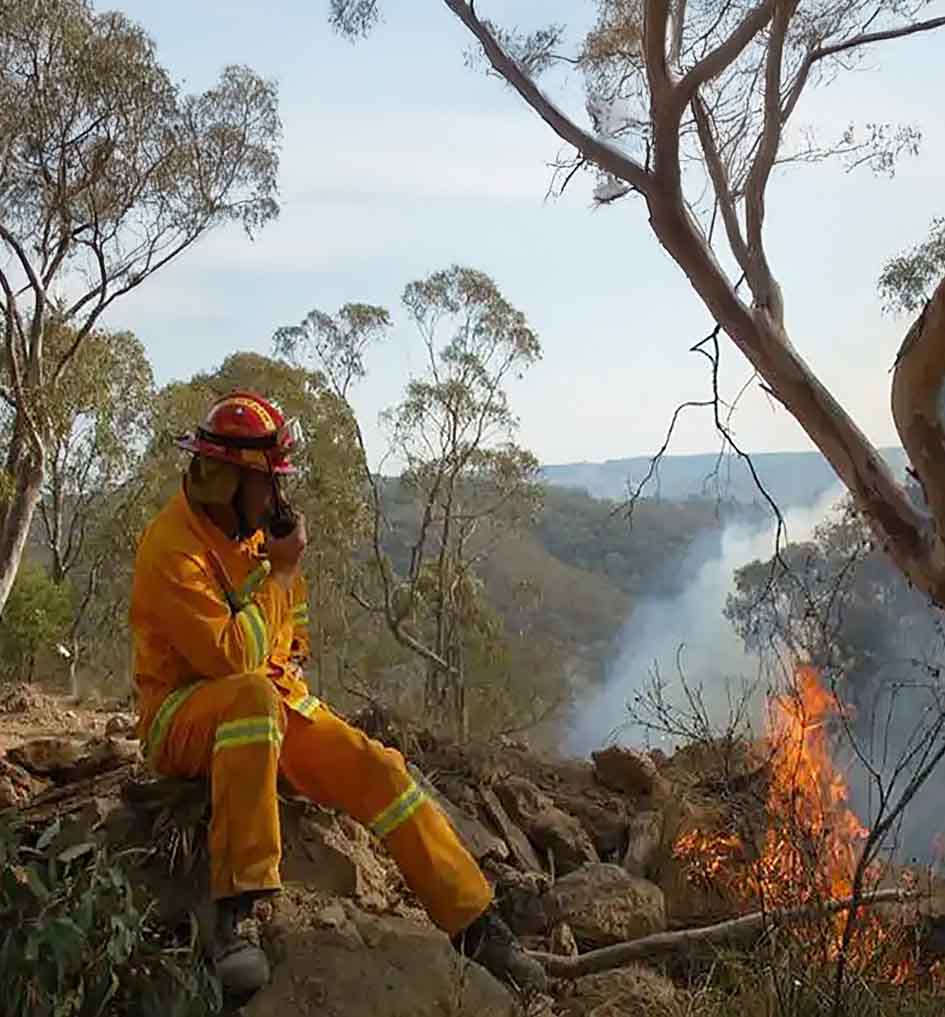
The Outcomes Framework specifies the measures we track to assess progress in delivering this strategy. It includes a broad range of indicators that allow us to understand the impact and effectiveness of our activities and ensure we remain focused on our long-term vision.
We produce Outcomes Framework reports on a quarterly basis to inform evidence-based assessments of progress being achieved and to underpin a strong performance and accountability culture across CFA. We also conduct an annual review of the indicators to drive continuous improvement.
View our outcomes framework
